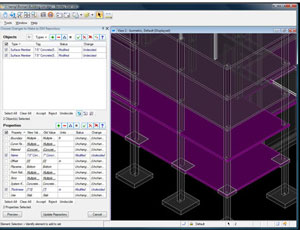Realizing that software interoperability only represents the potential to pass data between differing software products and is not an end in itself, Bentley Systems Inc., Exton, Pa., has developed and is offering for free a set of workflow tools to help designers actually make good use of it.
The company announced on Jan. 27 that it is releasing free plug-ins that not only pass back and forth and back again models and tracked revisions within Bentley’s 3-D structural modeling program and two of Bentley’s analysis programs, but it also is giving away a plug-in for San Rafael, Calif.-based Autodesk’s Revit program that lets users put Revit in the workflow the same way. Additionally, the company is offering for free the application programming interface tool used to create the plug-ins to any software vendor who wants to enable the same capability for their programs as well.
In fact, vendors that use the API to create plug-ins will be able to take advantage of the same workflow management tools on projects integrating files from varied sources, even if no Bentley design or analysis software is involved. The company says it is in discussion with several unnamed third-party vendors who are interested in developing exchange tools for their products with the plug-ins. The company says it expects some of them to make announcements about it over the next few months.
Bentley calls the new offering Integrated Structural Modeling, describing it as “a shared repository of common structural model data,” in which “common” refers to types of objects whose geometry and properties commonly need to be coordinated in integrated project workflows. There are two user interfaces, Structural Synchronizer V8i and Structural Dashboard V8i. ISM-enabled structural tools currently include Bentley’s Structural Modeler—formerly known as Bentley Structural—RAM Concept and RAM Elements, as well as Autodesk Revit.
“In practice,” says Santanu Das, Bentley vice president for integrated engineering, “if you start modeling in Revit, then using the ISM plug-in for Revit, you export an ISM repository and then bring the model into any other product enabled for ISM.”
When users import an ISM, file it launches the synchronizer, which is a viewer and data panel that highlights revisions along with their attributions. The importer chooses whether to accept, reject or ignore suggested changes. If an architect passed a design file to a structural engineer, who passed it to a detailer, who passed it back the other way, the trail of versions and suggestions would be captured and the process of revisions and approvals tracked.
“ISM is a dynamic way of representing the data,” Das says. “It gives you that decision-making and going back and forth. What we are saying to the architect is, start in whatever software you want, then when you are done press this little ISM button, and send that file to the structural engineer. The structural engineer can use whatever product he uses and, when done, send it back to the architect as an ISM file. He will get all the changes, and on import, it pops up the change management window that reports all the engineer’s suggestions.”
The other tool, Structural Dashboard, lets structural engineers manage workflows for common project types, launch structural applications from a unified interface, create customized workflows for individual projects and embed an Internet interface.
Das says the next free release of the synchronizer, expected around midyear, will also include the ability to export to a variety of interoperable file formats, as well as ISM.
There are two reasons Das gives for Bentley’s release of the workflow products as free downloads: Interoperability is good for business, and Bentley wants to enable structural engineers, detailers and general contractors to get involved earlier in design than is now generally possible.
“We want to try to bring the detailer and the GC much earlier into the process so they are not the last ones to get the model and they can access the information as it is dynamically changing. [The detailers] can create their detailing model at the same time and get it in hands of GC for bidding as well,” Das says. “We are looking all the way from upstream to downstream and getting a lot of people at the table earlier.”
Das says Bentley has focused its first efforts on creating the ISM exchange tools for Bentley software used by building engineers. Das says the issue is one of ensuring that object terminology is consistently and correctly mapped when data moves from design to analysis and back again. “That’s really the effort that’s behind all this stuff,” he says. “Anybody can break it into a million pieces. The trick is to get it back together.”
Similar ISM exchange-tool releases are planned for Bentley software in other verticals, Das says, probably in the plant-design space next. “We wanted to get the building engineers’ process right first. We really want to nail this thing.”



Post a comment to this article
Report Abusive Comment